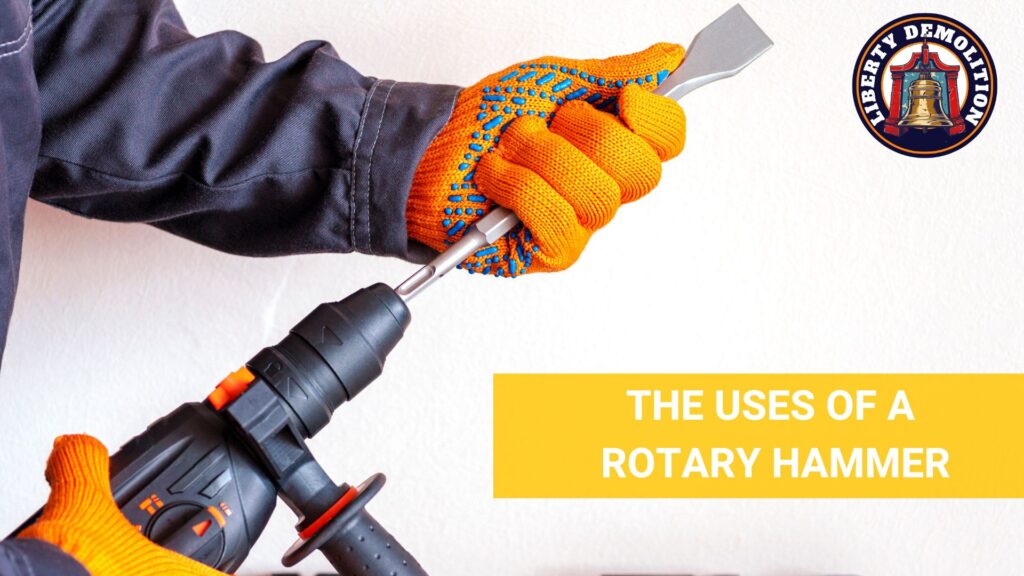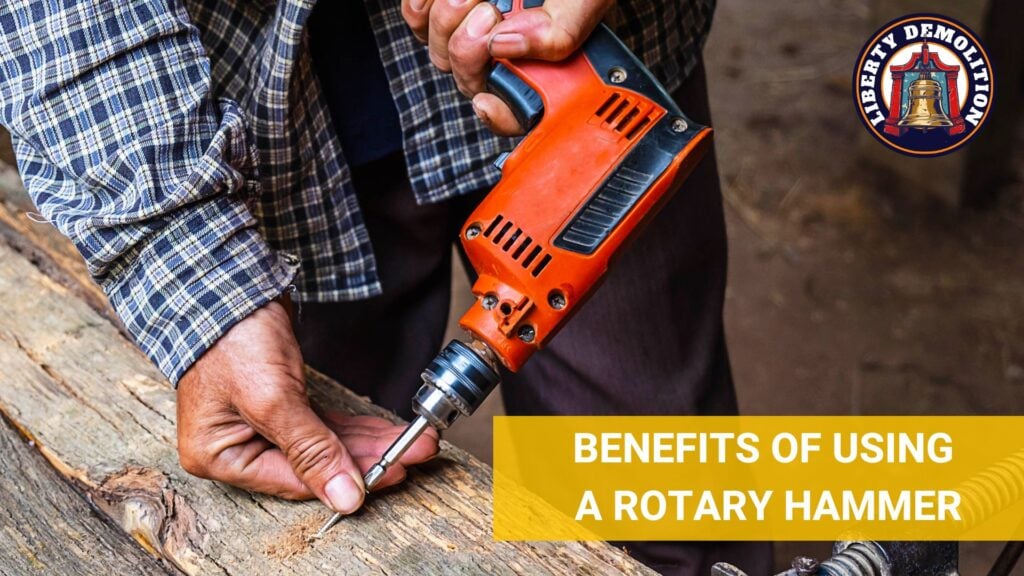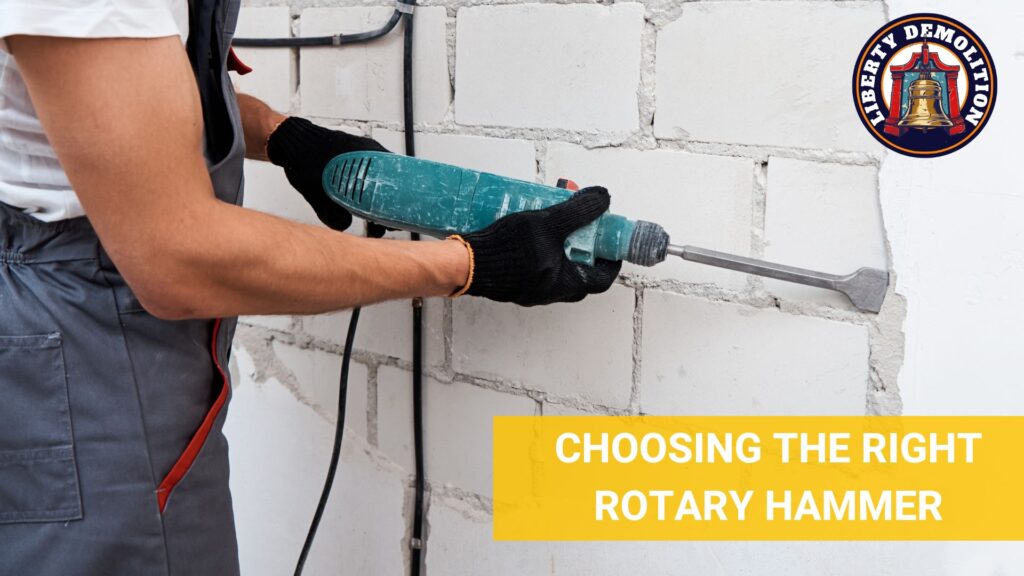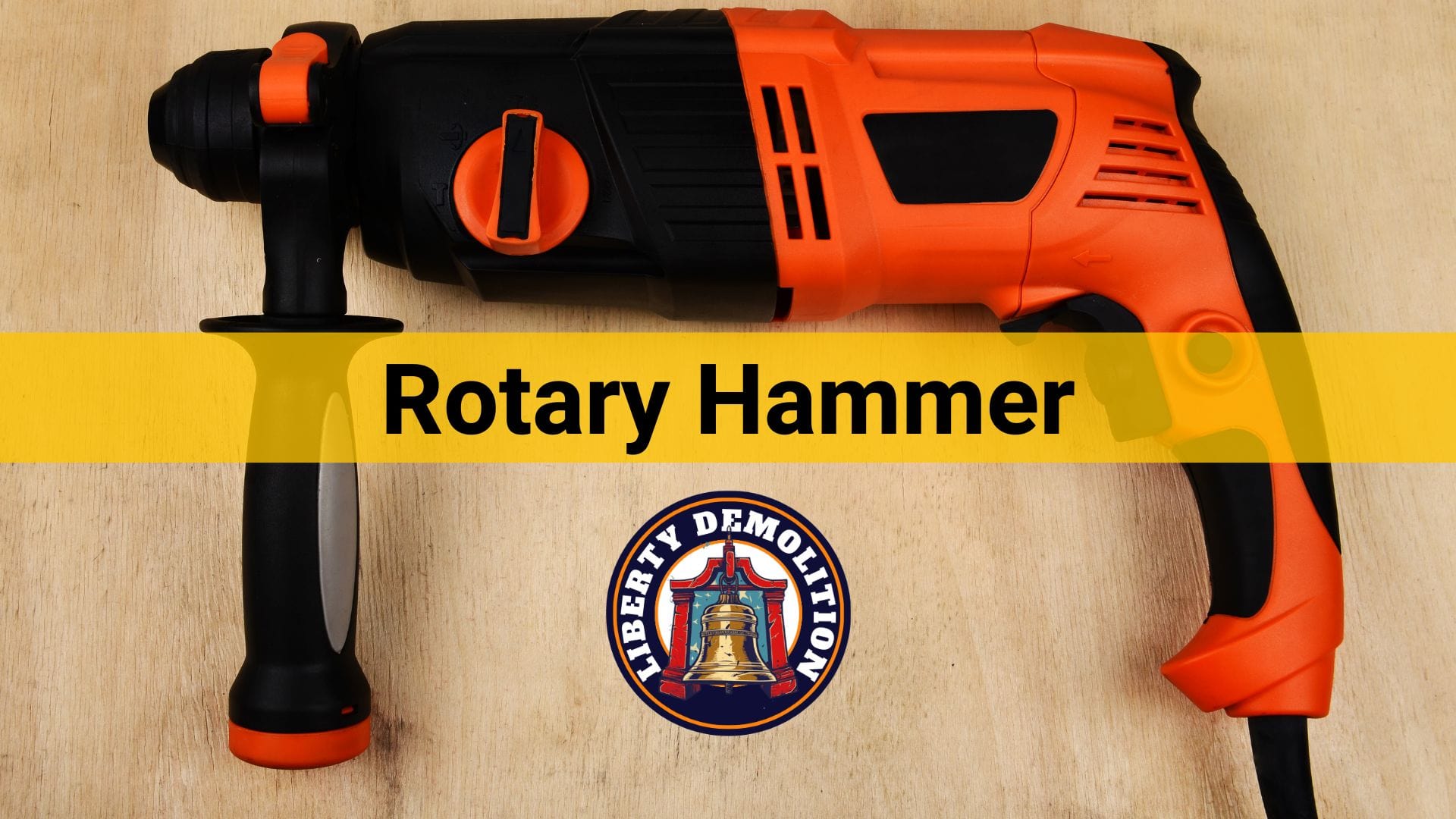A rotary hammer is a power tool used for drilling and chiseling hard materials like concrete, masonry, or stone. It combines rotation and a hammering action to penetrate tough surfaces efficiently.
Discover the mechanisms behind this powerful tool and its varied applications as you continue reading.
What Is a Rotary Hammer?
A rotary hammer, often confused with a regular hammer drill, stands out due to its specialized function and design. While both tools can drill into hard materials, the rotary hammer is designed for more intense tasks and can handle heavy-duty operations with ease. It is a preferred choice for professional demolition contractors who often work on concrete or other tough materials.
Here are the parts that comprise this power tool:
1. Motor and Power Source: Corded vs. Cordless
Motor
The motor provides the necessary energy for the tool to perform its functions, rotating the drill bit and providing the hammering action. The power of the motor is typically measured in watts or amperes, with higher numbers indicating more power. This directly translates to the rotary hammer’s capacity to handle tougher jobs and penetrate harder materials.
Corded Rotary Hammers
Corded models are directly plugged into an electrical outlet. This direct power source means they usually offer more consistent power and can operate for extended periods without any decrease in performance. They’re ideal for long, heavy-duty tasks where uninterrupted power is vital.
The major drawback of corded versions is mobility. The cord can limit the reach, and users need to be close to a power source. This can sometimes be restrictive, especially in remote or open work areas.
Cordless Rotary Hammers
These models are powered by rechargeable batteries, often lithium-ion. The main advantage of a cordless rotary hammer is its portability. Users can carry it anywhere, so it’s perfect for jobs where electrical outlets are not readily available or for tasks that require frequent repositioning.
The downside is that, depending on battery capacity and the intensity of the task, the tool might need frequent recharging. This can lead to downtime if additional charged batteries aren’t on hand. Additionally, over time, batteries may degrade, which can lead to reduced runtimes.
2. The Drill Bits and Chisels: Variations and Uses
Drill Bits
Drill bits are designed to bore into materials. The type of bit chosen depends on the material you’re working with and the size of the hole you aim to create. Here are some of the primary variations:
- SDS (Slotted Drive System) Bits: Commonly used with rotary hammers, these bits offer a secure fit and quick change capability. There are various types, such as SDS-Plus and SDS-Max, each designed for specific hammer sizes and tasks.
- Masonry Bits: These are made with tough, durable tips, usually of carbide, to drill into hard materials like brick, stone, or concrete.
- Spiral Bits: These bits feature a spiral design to help remove debris from the hole and ensure efficient and smooth drilling.
Uses:
- Hole Drilling: For simple hole drilling in masonry or concrete, regular masonry bits suffice. They’re perfect for tasks like setting up wall plugs or mounting frames.
- Deep Drilling: For deeper holes, like those needed for large bolts or anchors, longer SDS bits would be more appropriate.
3. Chisels
Chisels, unlike drill bits, are designed for breaking, chipping, or scraping hard materials. Here are some of the primary variations:
- Flat Chisels: These have a flat tip and are used for general breaking and chipping tasks.
- Pointed Chisels: With a pointed tip, these are used for precise breaking tasks or for creating starting points.
- Tile Chisels: These are specifically designed to remove tiles without damaging underlying surfaces.
- Gouge Chisels: With a curved edge, these are utilized for tasks that require grooves or channels.
Uses:
- Material Removal: For tasks like removing tiles, tile chisels would be ideal. For scraping off plaster or other materials, flat chisels might be more suitable.
- Breaking and Demolition: Pointed and flat chisels can be used for breaking concrete, stone, or brick. Their robust design ensures that they can handle the hammering action without breaking.
- Shaping: For tasks that require shaping or carving, gouge chisels can come in handy. They provide precision and control.
4. Clutch Mechanism and Safety Features
Safety and precision in operation are crucial when working with power tools like the rotary hammer.
Clutch Mechanism
The clutch mechanism in a rotary hammer acts as a mediator between the motor and the drill bit or chisel. When the tool faces resistance beyond a specific limit – for example, when the bit hits rebar or a particularly hard spot in concrete – the clutch disengages. This prevents both the tool and the user from experiencing a sudden jerk or torque reaction.
The clutch safeguards the motor and other internal components from potential damage due to excessive resistance. It ensures that users don’t experience sudden, unexpected movements, reducing the risk of injury. By preventing tool lock-up, it allows for smoother operations and prolongs the tool’s lifespan.
Safety Features
Power tools, given their nature, come with inherent risks. Rotary hammers are no exception. However, modern designs incorporate various safety features to mitigate these risks. Some of the primary safety features include:
- Anti-Vibration System: Prolonged exposure to vibrations can lead to conditions like Hand-Arm Vibration Syndrome (HAVS). Many rotary hammers now come with anti-vibration technology that dampens the vibrations felt by the user.
- Depth Stops: This feature allows users to set a specific depth for drilling. Once the drill reaches the set depth, it stops.
- Secondary Handles: An additional handle provides users with better control over the tool, especially during heavy-duty tasks.
- Dust Extraction: Many rotary hammers come with dust extraction features or compatibility with dust extractors. This ensures that the work environment remains clean, reduces the risk of inhaling harmful particles, and enhances visibility during operation.
- Overload Protection: Some advanced models have features that detect when the tool is being pushed beyond its limits.

What Is a Rotary Hammer Used For?
A rotary hammer is a versatile tool, often the go-to choice for tasks that other drills can’t handle. Here’s a look at its primary uses:
1. Drilling in Hard Materials
Rotary hammers are specially designed to drill into tough materials. Their hammering action, combined with rotation, enables them to penetrate:
- Concrete: One of the most common uses. Whether it’s setting up anchor bolts or drilling holes for electrical conduits, rotary hammers make the task easier.
- Masonry: Drilling into bricks, blocks, or any other masonry structures becomes efficient with this tool.
- Stone: Natural stones, which can be incredibly dense, are no match for a powerful rotary hammer.
2. Heavy-duty Chiseling
Apart from drilling, the rotary hammer is also designed for chiseling tasks:
- Breaking Concrete or Masonry: Need to create a channel in a wall or break down a part of a concrete floor? The rotary hammer, when equipped with the right chisel, can handle such heavy-duty tasks with ease.
- Tile Removal: With a tile chisel, rotary hammers can make the task of removing old tiles swift and less difficult.
- Sculpting Stone: For artists or craftsmen working with stone, a rotary hammer can assist in shaping and sculpting tasks.
3. Core Drilling
For tasks that require large diameter holes, like for pipes or ducts, rotary hammers can be equipped with core bits. This allows for core drilling, creating clean, large-diameter holes in tough materials.
4. Ground Rod Driving
Electricians or professionals setting up grounding systems often need to drive ground rods deep into the earth. A rotary hammer, equipped with a ground rod driver attachment, can make this task simpler and faster.
5. Tamping
With a tamping plate attachment, rotary hammers can be used to compact loose soil or gravel. This is particularly useful in landscaping or when setting up posts.
6. Wood Drilling
While not its primary function, when equipped with the right bit, a rotary hammer can also drill into wood, especially when dealing with large diameters or dense lumber.

Benefits of Using a Rotary Hammer
The rotary hammer, owing to its robust design and specialized features, offers several advantages over conventional drills, especially when it comes to demanding tasks.
Enhanced Drilling Efficiency in Masonry and Concrete
- Superior Penetration: The combined action of rotation and hammering means rotary hammers can bore into dense materials like concrete and masonry faster and more efficiently than standard drills.
- Less Effort Required: Given their design, rotary hammers require considerably less pressure from the user to drill into hard materials.
- Consistent Performance: Unlike traditional drills that may struggle or stall when faced with dense materials, rotary hammers maintain consistent performance.
Multi-functionality: Drilling, Hammering, and Chiseling
- Versatility: A single rotary hammer can serve multiple purposes. By simply changing the attachment, users can shift between drilling, hammering, and chiseling.
- Space Saving: For professionals who need to be mobile, carrying one tool instead of three can save valuable space and weight in their toolkit.
- Ease of Use: Switching functions in modern rotary hammers is typically straightforward, often requiring just the push of a button or a simple adjustment.
Reduced User Fatigue Due to Vibration Control Features
- Comfortable Operation: Many rotary hammers come equipped with anti-vibration technology.
- Health Benefits: Consistent exposure to vibrations can lead to medical conditions affecting the hands and arms. By minimizing these vibrations, rotary hammers ensure that users are at a lower risk of developing such issues.
- Improved Precision: Reduced vibrations mean steadier hands. This is especially crucial for tasks that require exact measurements or delicate handling.

Selecting the Right Rotary Hammer for the Job
Choosing the appropriate rotary hammer for your specific needs can make a world of difference in the quality, efficiency, and ease of your work.
1. Sizing: SDS-Plus vs. SDS-Max and Other Variants
SDS-Plus:
The SDS-Plus system is designed for the lighter end of the heavy-duty spectrum. The bits have a 10mm shank with slots that fit into the corresponding rotary hammer. They are ideal for drilling holes up to 3/4-inch diameter or for light chiseling tasks. It’s perfect for tasks such as fixing wall plugs, mounting frames, or drilling small to medium-sized holes in masonry or concrete.
They are generally more compact and lightweight than their SDS-Max counterparts, making them suitable for overhead tasks or working in tight spaces. However, they are not suited for very large drilling or heavy-duty chiseling tasks due to their size and power limitations.
SDS-Max:
SDS-Max is built for the more demanding end of the spectrum. The system features an 18mm shank with a more substantial slot design, which caters to larger and more powerful rotary hammers. It is best suited for drilling larger holes or for more intensive chiseling and breaking tasks. If you’re looking to drill holes for large anchors, break concrete, or undertake significant masonry work, this is the system to consider.
They offer more power and can handle tougher jobs with ease. Their design also ensures a more secure fit, reducing the chances of the bit slipping during heavy-duty tasks. The downside is these rotary hammers tend to be bulkier and heavier, which might make them less suitable for extended use or overhead tasks.
Other Variants:
There are other systems like the standard SDS and the Spline drive. While less common than the aforementioned systems, they have specific applications and benefits. The standard SDS is a predecessor to SDS-Plus and is less common in modern tools. Spline drive, on the other hand, is an older system that some professionals still prefer for specific tasks due to its unique shank design and fit.
2. Power Needs: Corded vs. Cordless
A significant consideration when selecting a rotary hammer is the power source.
Corded Rotary Hammers
Corded models draw power directly from an electrical outlet, which ensures a steady, uninterrupted supply. This means they can offer peak performance throughout their operation. Given their consistent power, corded rotary hammers are a natural fit for tasks that require extended operational periods without the need to recharge or replace batteries.
For jobs that demand consistent high power, like extensive chiseling or drilling into very dense materials, corded models are ideal due to their sustained power output. With a direct power source, there’s no need to pause for battery recharges. Many corded models offer higher power outputs compared to their cordless counterparts. However, the presence of a cord can restrict movement and might require users to be near an electrical outlet. This can be a limitation in remote job sites or vast areas.
Cordless Rotary Hammers
Cordless rotary hammers utilize rechargeable batteries, often lithium-ion, as their power source. This grants them a degree of mobility that corded models can’t match. They are specifically helpful in places where electrical outlets are inaccessible or non-existent. For tasks that require frequent repositioning or moving from spot to spot, the absence of a cord is a significant advantage.
The downside is depending on the model and the task’s intensity, users might find themselves needing to recharge or swap out batteries. This can introduce downtime, especially if spare batteries aren’t readily available. Some cordless models might not offer the same peak power outputs as their corded counterparts, especially as the battery’s charge depletes.
3. Features to Consider: Variable Speed, Anti-Vibration, Depth Stops
Selecting a rotary hammer based solely on its power source or size can be limiting. Modern tools come with a range of additional features designed to enhance user experience, precision, and safety.
Variable Speed
Variable speed allows users to adjust the rotary hammer’s rotation speed. This is crucial when working with different materials or when performing tasks that require varying levels of delicacy. Materials like softwood or delicate tiles might require a slower drilling speed to prevent damage, while concrete or brick might be tackled at full speed.
With variable speed, one tool becomes suitable for a broader range of materials and tasks. Users can dictate the pace, which ensures that the tool aligns perfectly with their needs at any given moment.
Anti-Vibration
Anti-vibration technology minimizes the vibrations transferred from the tool to the user’s hands and arms. For tasks that require extended periods of tool use, anti-vibration features can make the experience significantly more comfortable. Reduced vibrations can help users maintain accuracy and precision even after extended use.
Depth Stops
Depth stops allow users to set a desired drilling depth. Once that depth is reached, the feature prevents further drilling. This feature guarantees uniform hole depths, ensuring consistency in tasks. It prevents over-drilling, which can damage tools or materials and pose safety risks.
Best Rotary Hammer Brands and Models in the Market
Several brands have made a mark in the industry due to their consistent delivery of quality and innovation. Here are some, including their pros and cons:
1. Bosch RH328VC
This model boasts a robust 8.0 amp motor and offers both comfort and performance.
Pros:
- Its 8.0 amp motor ensures consistent performance for both drilling and chiseling tasks.
- Offers comfort during prolonged use due to its vibration reduction feature.
- Known for its long lifespan and resistance to wear and tear.
Cons:
- It’s slightly on the heavier side, which might make overhead tasks more challenging.
- Generally, a more expensive option compared to some competitors.
2. DeWalt DCH273P2
A cordless model equipped with a brushless motor, it offers extended runtime and is known for its durability and power.
Pros:
- Offers mobility and flexibility due to its battery-powered design.
- Brushless motor ensures longer tool life and extended battery runtime.
- Suitable for a range of applications, from drilling to light chiseling.
Cons:
- Although it offers good battery life, heavy-duty tasks might require battery swaps or recharges.
- The upfront cost, especially with batteries and charger included, can be high.
3. Makita HR4013C
This model stands out with its anti-vibration technology, which provides a more comfortable user experience while delivering robust performance.
Pros:
- Offers one of the best anti-vibration technologies in its class.
- With a 12.0 amp motor, it can handle demanding tasks with ease.
- Offers both hammering and chiseling functions for versatility.
Cons:
- It’s a bit bulkier, making it less suitable for tight spaces.
- Premium features come with a premium price tag.
4. Hilti TE 60-ATC-AVR
Recognized for its advanced safety features, this rotary hammer offers active torque control and vibration reduction.
Pros:
- Active Torque Control (ATC) stops the tool body from spinning uncontrollably if the drill bit jams.
- The AVR feature ensures reduced vibrations for comfortable use.
- It’s known for consistent, powerful performance in various tasks.
Cons:
- Hilti tools generally come at a premium price.
- Replacement parts or accessories might be less available compared to more common brands.
Frequently Asked Questions
Rotary hammers are versatile tools, but their capabilities often lead to several questions among users, especially when it comes to tasks outside of masonry or concrete drilling.
Can I Use a Rotary Hammer To Drill Metal?
Yes, you can use a rotary hammer to drill into metal. However, there are a few things to keep in mind:
- Bit Selection: Ensure you’re using a bit specifically designed for metal. Typically, this would be a high-speed steel (HSS) bit.
- Mode Selection: Rotary hammers usually come with multiple operational modes. When drilling into metal, ensure the tool is set to the “drill-only” mode without the hammering action.
- Speed and Pressure: Drilling into metal requires a steady hand and consistent speed. Applying too much pressure can result in the bit breaking or the metal being damaged.
Can a Rotary Hammer Drill Wood?
Yes, a rotary hammer can be used to drill wood, especially when dealing with large diameters or dense lumber.
- Bit Selection: Just like with metal, ensure you’re using a bit designed for wood. A wood auger bit or a spade bit would be appropriate choices for rotary hammers.
- Mode Selection: Use the “drill-only” mode. The hammering action is not suitable for wood and can cause splintering or damage.
- Consideration: While rotary hammers can drill into wood, it might be overkill for many woodworking tasks. Traditional drills or impact drivers could be more efficient and offer better control for delicate woodwork.
Can Rotary Hammers Be Used as a Screwdriver?
Technically, with the right bit or adapter, a rotary hammer can be used to drive screws. However, there are several factors to consider:
- Torque Control: Unlike dedicated screwdrivers or impact drivers, most rotary hammers do not have torque control. This means there’s a risk of over-driving or stripping the screw.
- Weight and Size: Rotary hammers are generally heavier and bulkier than standard drills or drivers. This can make them less maneuverable for driving screws, especially in tight spaces.
- Recommendation: While possible, it’s not the best tool for the job. If screw driving is a primary task, investing in a dedicated drill driver or impact driver would be a wiser choice for efficiency and precision.
Gearing Up for a Project
With the multifaceted functionality of rotary hammers, they cater to various tasks, including drilling, chiseling, or even, occasionally, working with metal and wood. Understanding the key components, their uses, and the features of different models empowers both professionals and DIY enthusiasts to make informed decisions and ensure efficiency, safety, and longevity in their projects.
If you’re venturing into tasks that require expert demolition contractors in Philadelphia, look no further than Liberty Demolition. Our commitment to safety, environmental responsibility, and unparalleled customer satisfaction mirrors the precision and efficiency of a top-notch rotary hammer. Choose Liberty Demolition for a seamless, environmentally-conscious solution to all your demolition needs.






